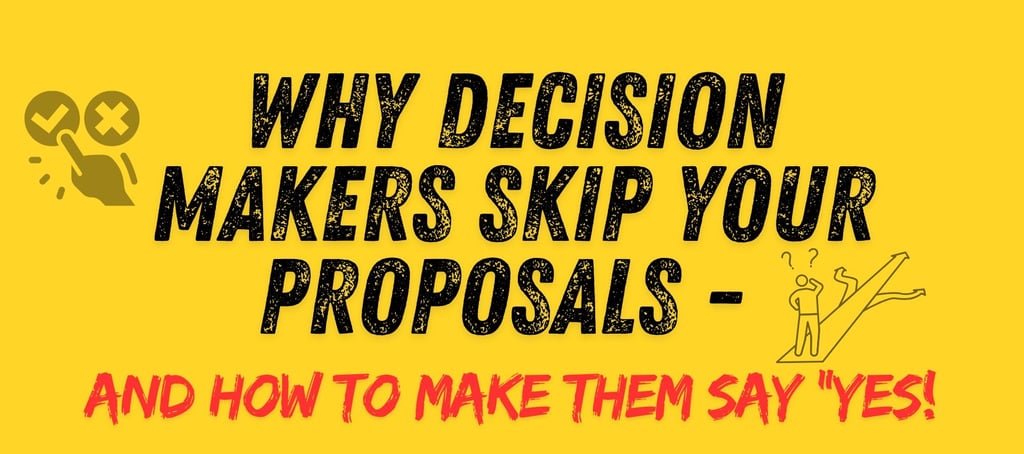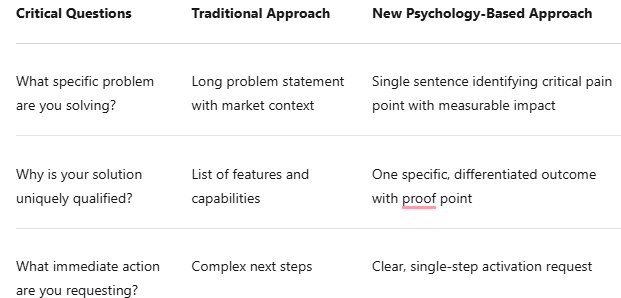Why Decision Makers Skip Your Proposals - and How to Make Them Say “Yes!


Ever poured hours into a proposal, only to hear, “I’ll think about it”? 😩 Here’s why this happens - and how to make your pitch irresistible.
Last week, I overheard a conversation that perfectly illustrates why decision-makers often skip proposals. A barista pitched a coffee subscription to an executive who barely engaged. Sound familiar? 🤔
🎯 The Problem: Decision Fatigue
Decision-makers face an average of 35,000 decisions daily. By the time they get to your proposal, they’re mentally exhausted. The result? They skip it.
Why?
Overload: Too much information = shutdown.
Prevention focus: They look for risks, not benefits.
Snap judgments: First impressions are made in 3 seconds.
I learned this the hard way when a client's meticulously crafted 30-page proposal was rejected without discussion. The deal-breaker? A single line about implementation timing that triggered uncertainty.
🚀 The Fix: A New Proposal Strategy
1️⃣ Make It About Them, Not You
💬 Stop opening with, “We’re the market leader…”
👉 Instead, start with their pain point:
Instead of: “Our software integrates seamlessly.”
Try: “Struggling with disconnected systems? Here’s how we streamline your workflow.”
2️⃣ Personalize Everything
🖋️ Generic templates don’t work. Tailor your pitch with:
🎉 Celebrating their wins: “Congrats on your recent $5M funding!”
🛠️ Addressing industry challenges: “We know supply chain delays cost manufacturers millions.”
🔗 Referencing past talks: “As we discussed, scaling while maintaining quality is key for you.”
3️⃣ Simplify to Amplify
📚 Dense proposals? A big no-no. Instead:
Use bullet points.
Add visuals or icons.
Keep paragraphs short and punchy.
4️⃣ Include a Clear Call-to-Action (CTA)
✨ Don’t leave them wondering, “What now?” End with:
“Book a demo this week to see the results yourself.”
“Sign here to get started—we’ll handle the rest!”
Real-Life Example
Remember the barista who pitched a coffee subscription? She flipped her approach:
Old Pitch: “Here’s why our coffee is great.”
New Pitch: “What’s your biggest morning frustration?” Result? A bulk order for the entire office.
The Bigger Picture: Decision-Making Psychology
Decision-making is influenced by emotions, biases, and mental shortcuts. Understanding these factors is key to crafting resonant proposals.
Practical Application: The New Proposal Framework
The Three-by-Three Rule: Answer three critical questions in three seconds.
The Psychology of Presentation: How Proposals Are Read
Eye-Tracking Studies on Proposals:
Top-Left Priority: Place critical info here.
Visual Hotspots: Use charts or icons.
F-Pattern Scanning: Write short, bolded headers.
The Role of Emotion in Reading:
Clarity: Avoid uncertainty.
Trust: Show authority.
Urgency: Use time-bound CTAs.
🧠 Key Takeaway
The secret to winning proposals isn’t about adding more. It’s about connecting with their psychology:
Address their pain.
Build trust.
Make action easy.
🔔 Follow for More: Don't miss out on future articles packed with practical tips and inspiring ideas.
Visit my website Kamaleonte Marketing.
Subscribe to my newsletter AI Sapiens.
Stay informed, stay adaptable, and keep thriving


